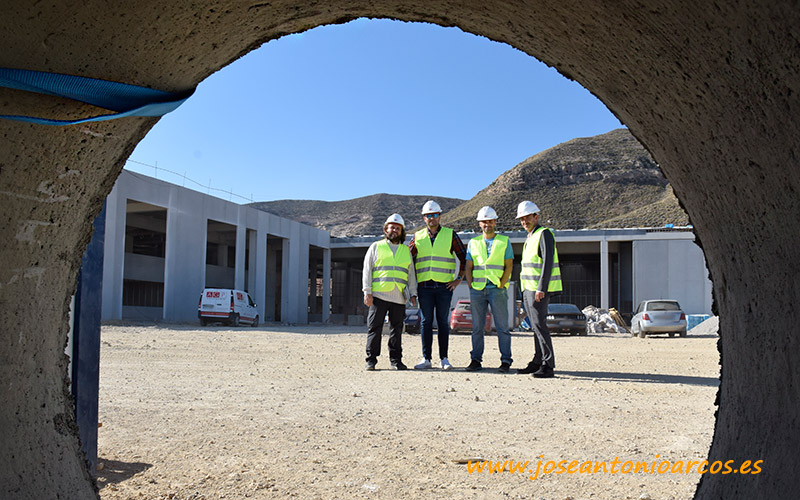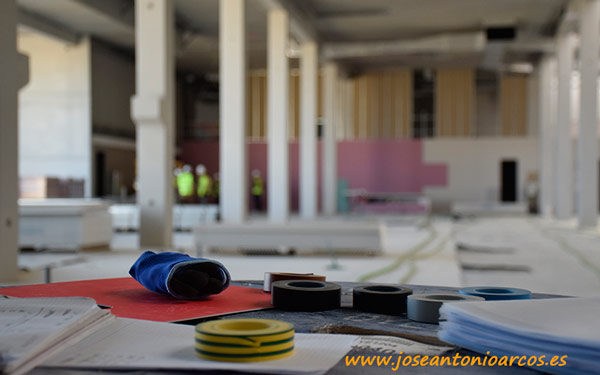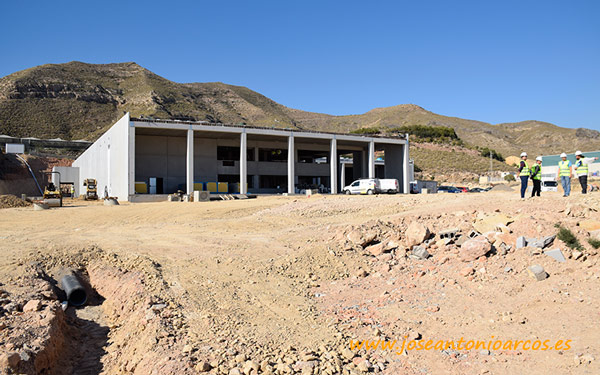Solo hace falta levantar la mirada cuando se transita en el Poniente almeriense por la A-7 a la altura de Vícar. Presidiendo la comarca hortofrutícola por excelencia se está levantando en la actualidad el que va a ser el ![]() mayor centro de investigación en biopesticidas y biofertilizantes del mundo agrícola. Ana y yo nos poníamos el casco hace unos días para conocer in situ el estado de las obras y la envergadura de un proyecto que abruma por su singularidad.
mayor centro de investigación en biopesticidas y biofertilizantes del mundo agrícola. Ana y yo nos poníamos el casco hace unos días para conocer in situ el estado de las obras y la envergadura de un proyecto que abruma por su singularidad.
Recuerdo cuando hace justo ahora dos años avanzábamos en el blog el plan de construcción de este macro centro de I+D+i. En aquel momento solo había maquetas y muchos números, transcurrido este tiempo el proyecto inicial se ha transformado en realidad y para este próximo mes de junio ya estará concluida la primera fase.
Se invertirán 12 millones de euros para levantar este templo de la ‘agricultura verde’ que aspira a erigirse en alternativa global a la química de síntesis. Este nuevo enclave, el MAAVi Innovation Center, se levantará sobre cuatro grandes pilares que a su vez vertebrarán la estructura de todo el edificio, de sus laboratorios, departamentos e investigadores: botánica, microbiología, microalgas y química verde.
Es una revolución que abanderará en realidad Almería, ya que el centro de Kimitec Group presidirá como un balcón, por su ubicación física, todo el ‘mar de plástico’ que será testigo del salto cualitativo hacia adelante que se fragua desde las entrañas del propio ‘modelo Almería’. Y es que lo que me queda claro es que más allá de la propia marca del grupo Kimitec como empresa, de manera explícita será la agricultura de invernadero almeriense la que saldrá beneficiada en términos de imagen al identificarse con un modelo de producción cada día más sostenible y que da cobijo en su seno a la investigación de vanguardia en biopesticidas, prebióticos y probióticos.
Con Félix García, CEO de la compañía, penetramos en el corazón de la obra. Así pudimos saber que desde la entrada el futuro visitante se adentrará en un viaje a un nuevo modelo disruptivo de agricultura, ya que los cuatro pilares antes descritos estarán presentes a cada paso que se dé por los distintos espacios del MAAVi Innovation Center. Será un centro abierto por el que pasarán, por ejemplo, colegios, asociaciones y otros colectivos que quieran ser copartícipes del movimiento Agro-biótico impulsado por Kimitec Group.
Qué es una fermentación o qué es una extracción o por qué el suelo es como el estómago de una planta al que podemos alimentar con hongos y bacterias (probióticos) serán solo algunas paradas en el itinerario que en el futuro hará el visitante a este centro que en primicia Ana y yo teníamos la suerte de recorrer hace pocos días.
Tecnologías de vanguardia
Sin querer ser exhaustivo, sí pasaré a nombrar los principales campos de conocimiento en los que se trabajará en el MAAVi Innovation Center. Habrá áreas de botánica, microalgas y microbiología en las que se identificarán nuevas cepas con actividades biopesticidas, bioestimulantes o simbióticas, entre otras actividades.
También un área de cultivos celulares donde se implementarán estudios que demuestren la actividad saludable de vegetales cultivados en sinergia con ciertos microorganismos, con aplicación de bioestimulantes, entre otros.
Además un área de fermentación para el estudio de condiciones de cultivo de todo tipo de microorganismos; un área de analítica y otra de formulación; varias áreas de extracciones; otra área de plagas; de plantas piloto fotobiorreactores; de fermentación industrial y de extracción y concentración industrial.
Una de las futuras áreas que merecen mención especial es la de los fitotrones que permitirán el desarrollo a pequeña escala de ensayos sobre plantas en condiciones totalmente controladas y donde se podrán reproducir y simular las condiciones propias de cualquier parte del planeta. Además se podrán generar situaciones de estrés extremo. Con los fitotrones se tendrá capacidad de emular climas extremos desde -5ºC a 35ºC o condiciones de humedad del 0% al 100%.
Y por supuesto habrá una importante zona de más de 2.000 metros cuadrados de invernaderos de ensayos, de una superficie total de 5.600 metros que cubrirá el centro de I+D+i. En estos invernaderos también habrá lugar para el estudio del cannabis medicinal, asunto que será merecedor de otro artículo futuro.
Como así también habrá que dejar para próximas publicaciones la segunda fase de las nuevas instalaciones de Kimitec Group, donde se ubicará la fábrica de producción y otros espacios que entroncan con la responsabilidad social corporativa. Pero hoy toca hablar de investigación y del inminente nacimiento de un centro que supondrá un antes y un después en muchos aspectos de nuestro campo.
The temple of Kimitec rises
You just need to raise your eyes when you drive down A-7, at the height of Vícar, located on the western side of Almería. Presiding over the fruit and vegetable region par excellence, the soon-to-be biggest research center in biopesticides and biofertilizers of the agricultural world is currently being built. Ana and I were putting on helmets a few days ago to witness, in-situ, the state of the construction and the size of a project that is overwhelming due to its uniqueness.
I remember when, two years ago, we were first blogging about the plans for building this R + D + i center. At the time, there was only scale models and many numbers, however, the initial project has now become a reality and this June, the first phase will be concluded.
12 million euros will be invested to build this ‘green agriculture‘ temple that aspires to become a global alternative to synthetic chemistry. This new enclave, the MAAVi Innovation Center, will be built on four main pillars that in turn will give shape to the structure of the entire building, its laboratories, departments and researchers: botany, microbiology, microalgae and green chemistry.
It is a revolution that Almería will actually champion, being that the center belonging to Kimitec Group will preside due to its physical location, as if on a balcony, over all the ‘sea of plastic‘ that will become witness of the qualitative leap forward, forged within the womb of the ‘Almería model’ itself. What seems clear to me, is that beyond Kimitec group’s own brand as a company, it will be explicitly Almeria’s greenhouse agriculture that will benefit in terms of image, by identifying itself with an increasingly sustainable production model which also shelters the cutting-edge research development, in biopesticides, prebiotics and probiotics.
With Felix Garcia, CEO of the company, we pierce into the heart of the construction. At the entrance, we realize that the future visitor will immerse themselves into the journey of this new disruptive model of agriculture, being that the four pillars described above will be present at each step taken through the different areas of the MAAVi Innovation Center. It will be an open center, accessible to, schools, associations and any other groups interested in becoming part of the Agro-biotic movement led by Kimitec Group.
What is fermentation? What is an extraction? or How is the soil like the plant’s stomach that we can feed with fungi and bacteria (probiotics)? These are just a few of the themes that will be addressed in the tour that visitors to the center will have access to in the near future, the center that Ana and I were fortunate to visit a few days ago.
Forefront technology
Without wanting to be thorough, I will mention the main fields of knowledge in which the MAAVi Innovation Center will focus on. There will be areas of botany, microalgae and microbiology where strains with biopesticide, biostimulant or symbiotic action, will be identified.
Also, a cell cultivation area, where studies that demonstrate the healthy activity of vegetables grown in synergy with certain microorganisms will be carried out, with application of biostimulants, among others.
In addition, a fermentation area dedicated to the study of growing conditions of all types of microorganisms; an area of analytics and one for formulations; several extractions areas; another area for pests; a photobioreactor pilot-plant area; as well as areas for industrial fermentation, extraction and concentration.
One of the areas that deserves special mention is that of the phytotrons, which will allow the small-scale trial development on plants under totally controlled conditions and where the conditions of any part of the planet can be reproduced and simulated. Additionally, situations of extreme stress can be generated. In the phytotrons area, it will be possible to emulate extreme climates ranging from -5ºC to 35ºC or humidity conditions ranging from 0% to 100%.
And of course, there will be an important area of more than 2,000 square meters of greenhouses for trials, of a total area of 5,600 meters that will cover the R & D center. Within these greenhouses there will also be a place for the study of medicinal cannabis, an issue that will be worthy of a future article.
Similarly, the second phase of Kimitec Group’s new facilities, where the production factory and other spaces that connect with corporate social responsibility will be located, will have to be left for future publications. But today we must talk about research and the imminent birth of a center that will serve as a turning point within our field.
















